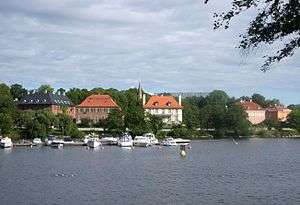Diplomatstaden

Diplomatstaden (Swedish for "The diplomat city") is a neighbourhood in the Östermalm district in central Stockholm, Sweden. As the name suggests, the neighborhood is the home of many embassies and ambassadorial residencies.
Diplomatstaden encompasses the area facing the Djurgårdsbrunnsviken bay which is located south of the easternmost part of Strandvägen. It is an exclusive residential area composed of a group of brick villas built mostly in the 1910s and 1920s.[1]
History
The municipal council had scrapped its plans for a Nobel institute in the neighbouring Nobel Park (Nobelparken) in 1906.[2] Instead, city planning authority Per Olof Hallman designed a city plan for the area in 1911 and 1914. His plan strictly specified what materials should be used and detailed much of the exterior shapes of the buildings. Additionally, the irregularly shaped sites, over time increasingly criticized by involved architects, strongly dictated the design of the buildings. Most buildings facing the street passing north of the area are surrounded by walls, while open gardens surround those facing the southern waterfront.[1]
Hallman placed the villas in a semicircle around the English Church (Engelska kyrkan). Designed by James Souttar in 1863, the church was originally located at Wallingatan north of the Norra Bantorget square, but was moved brick by brick to its present location in 1913. The first villa to be built was banker Philip Geber's (5, Nobelgatan), designed by Ragnar Östberg in 1913. Two years later, United Kingdom had their embassy built (7, Nobelgatan) to the design of British architect Sir Richard Allison.[1]
Villas
The villas in the area are:[1][3]
| Property | Address | Year | Architect | Initial owner | Current owner (2008) |
|---|---|---|---|---|---|
| Villa Geber | 5, Nobelgatan | 1913 | Ragnar Östberg | Philip Geber | Salvatore Grimaldi |
| Tryggerska villan | 3, Nobelgatan | 1914 | Ivar Tengbom | Ernst Trygger | Swedish Bar Association |
| Brittiska residenset | 7, Nobelgatan | 1915 | Richard Allison | United Kingdom | United Kingdom |
| Bünsowska villan | 15, Nobelgatan | 1919 | Carl Westman | Robert Bünsow | Saudi Arabia |
| Tillbergska villan | 9, Nobelgatan | 1919 | Ivar Tengbom | Knut Tillberg | South Korea |
| Villa Gumælius | 1, Nobelgatan | 1924 | Erik Trana | A. S:son Gumælius | Hungary |
| Villa Bonde | 20, Dag Hammarskjölds väg | 1925 | Cyrillus Johansson | Nils Gustaf Bonde | Turkey |
| Villa Wikström | 22, Dag Hammarskjölds väg | 1925 | Cyrillus Johansson | Carl Wikström | South Korea |
| Villa Josephson | 11, Nobelgatan | 1926 | Erik Josephson | John Josephson | Belgium |
| Villa Bonnier | 13, Nobelgatan | 1927 | Ragnar Östberg | Åke Bonnier | Sweden |
| Villa Hjorth | 26, Dag Hammarskjölds väg | 1930 | Curt Björklund | Berndt August Hjorth | Turkey |
| Villa Åkerlund | 2, Nobelgatan | 1932 | Knut Peterson | Erik Åkerlund | United States |
Notes
References
- Johansson, Bengt O H (1999). Guide till Stockholms arkitektur (in Swedish) (2nd ed.). Stockholm: Arkitektur Förlag AB. ISBN 91-86050-41-9.
- Stugart, Martin (2007-04-27). "Diplomatstaden vore kul att få veta mera om." (in Swedish). Dagens Nyheter. Archived from the original on 2012-01-29. Retrieved 2008-06-10.
- "Sveriges dyraste villa får ny ägare." (in Swedish). E24. 2010-08-30. Retrieved 2011-02-20.
External links
| Wikimedia Commons has media related to Diplomatstaden. |
- "Historical photographs of Diplomatstaden" (in Swedish). Stockholmkällan. Retrieved 2015-03-19.
Coordinates: 59°19′59″N 18°06′10″E / 59.33306°N 18.10278°E